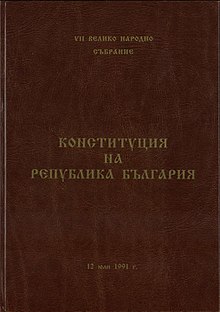Constitution of Bulgaria
The Constitution of Bulgaria ( Bulgarian Конституция на България / Konstitutzija na Balgarija) is the constitution of the Republic of Bulgaria . The current constitution was adopted on July 12, 1991 by the 7th Bulgarian Grand National Assembly and, after 50 years of communist rule, defines the country as a unified democratic, rule of law and parliamentary republic . It is the first constitution in Eastern Europe based on the principles of democracy and the rule of law. It is also one of the few, Ivan Adamovich speaks of the only one in Central and Eastern Europe that contains rules for the dissolution of the old constitution and the introduction of a new one. In this case the Great National Assembly meets .
The Bulgarian National Assembly can amend or supplement all provisions of the Constitution, with the exception of those for which the Grand National Assembly is responsible (Art. 153). It was changed four times (2003, 2005, 2006 and 2007), most recently in connection with Bulgaria joining the European Union (in the course of EU enlargement in 2004 ten states joined the EU on May 1, 2004).
Chronologically it is the fourth constitution of Bulgaria; the first was the Tarnovo Constitution of 1879 (it constituted Bulgaria as a constitutional monarchy ). The second in chronological order was the Constitution of the People's Republic of Bulgaria (also called the Dimitrov Constitution, named after Georgi Dimitrov ; in force between 1947 and 1971). The 1971 amended constitution is also known as the Zhivkov Constitution (named after Todor Zhivkov ).
literature
- Wolfgang Ismayr: The political system of Bulgaria. In: The political systems of Eastern Europe. VS Verlag, 2010, p. 679ff.
Web links
- The Constitution on the side of the Bulgarian Parliament
- The constitution on www.verfassungen.eu
See also
Individual evidence
- ^ Wolfgang Ismayr : The political system of Bulgaria. In: The political systems of Eastern Europe. VS Verlag, 2010, p. 679.
- ^ Ivan Adamovich: Origin of Constitutions: Economic Theory and Application to Central and Eastern Europe after 1989. Mohr Siebeck, 2004, p. 143.


